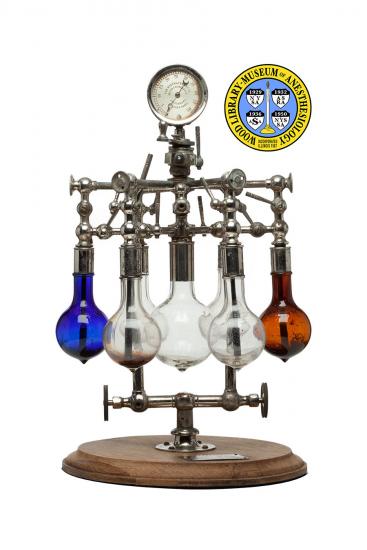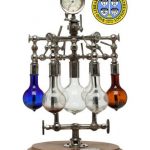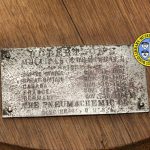Robertson Comminuter
Anesthesiologists help the patient to breathe during surgery and, if needed, during recovery from surgery. This includes ensuring that the air inhaled by the patient has the right amount of humidity. Steam and medications dissolved in steam, as well as other vapors and powders, have been used to treat illnesses of the nose, throat and lungs since the 18th Century. The introduction of antiseptic sprays by the English surgeon, Sir Joseph Lister (1827-1912) launched an era of intensive use of respiratory therapy devices in the late 19th and early 20th Centuries. Some surprising things were inhaled for the expected benefit of their antiseptic or stimulating properties, including iodine, ammonia, creosote, formaldehyde, camphor, paraffin, pumice and tobacco.
The American inventor, John Robertson patented the atomizer seen here in 1902. It could convert up to seven different liquids into vapor; the choice of agents was up to the physician. It was powered by an air compressor (missing from this example.) An adjustable valve could cause the vapor to be delivered in a rapidly pulsating stream. Robertson described this method as "treating affections of the lungs, throat and ear by massage".
Catalog Record: Robertson Comminuter
Access Key: akok
Accession No.: 2008-02-07-1
Title: Robertson’s multiple comminuter / [John Robertson].
Author: Robertson, John.
Corporate Author: The Pneumachemic Company.
Title variation: Alt Title
Title: Robertson comminuter.
Title variation: Alt Title
Title: Atomizing apparatus.
Publisher: Cincinnati, [Ohio] : The Pneumachemic Co., [1898-1910].
Physical Descript: 1 multiple-nebulizer ; metals, glass, wood : 56.5 x 37 x 36 cm.
Subject: Nebulizers and Vaporizers – instrumentation.
Subject: Respiratory Therapy – instrumentation.
Web Link: https://woodlibrarymuseum.org/museum/item/674/robertson-comminuter
Note Type: General
Notes: The early year (1898) in the date range for the possible year of manufacture
is based on the earliest advertisements that were found for the circular
model and on the patent application date for the circular version. The late
year (1910) in the date range for the possible year of manufacture is
generously based on the dates of publications that contain mention of, and
advertisements for, the device. Advertisements fall off after 1904. The
company may have folded due to financial problems. The following comment is
printed in the editorial section of the February, 1898 issue of the American
Medical Journalist: “The Pneumachemic Co., Neave Bulding, Cincinnati, Ohio,
is reported as being long on promises but short on pay.” Another indication
that the Pneumachemic Co. may have had financial difficulties are the
contents of advertisements in 1903 and 1904 stating that Robertson’s Improved
Multiple Comminuter, “Will be sold cheap for cash.” The date range could
change if documentation indicates it should be corrected.
Note Type: Citation
Notes: Anderson PJ. History of aerosol therapy: liquid nebulization to MDIs to DPIs.
Respir Care. 2005;50(9):1139-1150.
Note Type: Citation
Notes: Bause GS. Robertson’s Multiple Comminuter. Anesthesiology. 2011;115(4):668.
Note Type: Citation
Notes: For sale … Robortson’s improved Multiple Comminuter [advertisement]. Merck’s
Arch. June, 1904;6(6):xxiv.
Note Type: Citation
Notes: Realization of the ideal [advertisement]. Am Med Mon. March,
1899;16(12):xxxiv.
Note Type: Citation
Notes: Realization of the ideal [advertisement]. Med World. Mary, 1899;17(5):xiii.
Note Type: Citation
Notes: Richards D, ed. Lotus Illustrated Dictionary of Ecology. New Delhi: Lotus
Press; 2004:47.
Note Type: Citation
Notes: Robertson J, inventor. Atomizer. US patent 549,822. November 12, 1895.
Note Type: Citation
Notes: Robertson J, inventor. Atomizing apparatus. US patent 703,611. July1, 1902.
Note Type: Citation
Notes: Robertson, John, M.D. The Standard Medical Directory of North America, 1903-4
Chicago: G.P. Engelhard & Company; 1903;464.
Note Type: Citation
Notes: Robertson’s latest. Multiple Comminuter and air receiver combined
[advertisement]. Diet Hyg Gaz. December, 1898;14(12):vi.
Note Type: Citation
Notes: Stephenson RL, Blackburn JB Jr. Glossary of industrial wastewater and
environmental terms. The Industrial Wastewater Systems Handbook. Boca Raton:
CRC Press LLLC; 1998:438.
Note Type: Physical Description
Notes: One apparatus for the vaporization of medications; It consists of an
interconnected metal frame of pipes on a wooden base; The metal of the device
is spotted with corrosion; Like spokes on a wheel, six pairs of metal pipes
radiate from a central rectangular connection of pipes; At the end of each
extension (spoke) is a glass flask that looks a bit like an upside-down light
bulb; Four of the flasks are clear, one is blue and one is amber in color; A
larger mixing flask is located in the center of the apparatus; A number of
valves and stop-cocks are located throughout the device to precisely control
the direction of the flow of air or gas through the pipe system; Extending
from the center top of the apparatus is circular a pressure gauge graduated
in increments of 1 from 0 to 50; Text inside of the gauge includes, “THE
PNEUMACHEMIC CO. [new line] DR. JOHN ROBERTSON [new line] CINCINNATI, [new
line] LONDON & PARIS.”; A small logo from the Schaeffer & Budenberg Gauge
Company is also located on the face of the gauge; A corroded metal plate on
the round wooden base is engraved with the following, “ROBERTSONS’S [new
line] MULTIPLE COMMINUTER [new line] PATENTED [new line] UNTED STATES NOV.
-12-1895 [new line] GREAT BRITAIN NOV. -12-1895 [new line] CANADA MAR.
-10-1896 [new line] FRANCE NOV. -12-1895 [new line] GERMAN NOV. -121895 [new
line] THE PNEUMACHEMIC CO. [new line] CINCINNATI, O. U.S.A.”; The wooden base
is cracked; This device must be handled with care.
Note Type: Reproduction
Notes: Photographed by Mr. Steve Donisch, June 13, 2013.
Note Type: Historical
Notes: This device created a fine mist of up to six dissolved medications by
generating very fast and fine vibrations (the company claimed 1,000
vibrations per minute). a single medication or a combination of several
medications could be administered at one time. This was controlled by on-off
valves above each glass globe.
Today we might call this apparatus a nebulizer. Nebulizers deliver
medications and moisture into the airways. They may be used when a patient is
on a ventilator during anesthesia or when in the intensive care unit.
Nebulizers are also used in the treatment of some lung diseases, such as
asthma.
The inventor, Dr. John Robertson applied to patent the first version of this
device, which had a linear design, on November 12, 1895. A second patent, for
a new circular design, was filed on April 11, 1898. In 1899, four different
styles and 16 different sizes were available. Dr. Robertson was also the
manager and one of the owners of the company that manufactured and marketed
this device, The Pneumachemic Company.
During the mid-to late 19th Century the terms atomizer and nebulizer were
often interchanged. The patents referred to the device as an “atomizer” and
“atomizing apparatus”. The Pneumachemic Company referred to it as a
“Comminuter”. Today a comminuter is a machine that assists in waste treatment
by pulverizing solid materials, but because a synonym for ‘comminute’ is
‘atomize’ the choice was applicable.
Some advertisements for Robertson’s Multiple Comminuter offered to provide
“Robertson’s Revised Formulary” with the purchase of the apparatus. His
formulas would not have contained potent bronchodilators, which were not
commonly used in nebulizers until the 1930s. Bronchodilators are medications
that open up constricted airways.
Website visitors might want to compare this device to the very different
DeVilbiss Atomizers, at https://woodlibrarymuseum.
org/museum/item/524/devilbiss-atomizers.
Note Type: Exhibition
Notes: Chosen for the WLM website (noted November 25, 2013).



